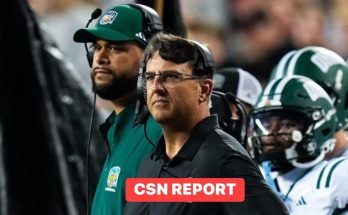Ben Johnson Said It Himself: “Expected Points Added (EPA) in the Passing Game Is the Most Critical Factor to Winning.” Now That Number Has Come Back to Haunt Him
Ben Johnson was hailed as one of the brightest offensive minds in football long before he was named head coach. As the architect behind Detroit’s offensive resurgence in the early 2020s, his rise was meteoric. He earned accolades for creativity, balance, and his deep understanding of modern offensive metrics—especially one he repeatedly championed: Expected Points Added, or EPA, particularly in the passing game.
“Expected Points Added in the passing game is the most critical factor to winning,” Johnson said in a now-infamous 2024 press conference. The data-backed statement resonated across analytics circles and football media, symbolizing a shift from the traditional to the calculated. Johnson wasn’t just coaching with his gut—he was leading with numbers, and the results initially backed him up.
But now, deep into the 2026 NFL season, the same metric Johnson once held up as the gold standard has become the source of scrutiny, criticism, and mounting pressure. According to the team’s internal reports and league-tracked data, Johnson’s squad ranks near the bottom of the league in EPA per dropback—a disastrous showing for a team that built its identity on elite passing efficiency.
This isn’t just a case of a statistical slump. It’s a philosophical reckoning for a coach who staked his brand on one number—and is now watching it expose the very flaws he’s struggling to correct.
When Johnson was promoted to offensive coordinator in Detroit, he quickly transformed the Lions’ passing game from a bottom-tier unit into one of the league’s most potent aerial attacks. Jared Goff—long viewed as a limited quarterback—experienced a career renaissance under Johnson’s watch, thanks to heavy play-action usage, tight formations, and intelligent motion schemes.
At the center of Johnson’s philosophy was the idea that passing efficiency mattered more than volume, and EPA was the best way to measure it. While traditional box score stats like passing yards or touchdowns can mislead, EPA per play accounts for down, distance, field position, and game context. It captures how well an offense adds value on a given play—and in Johnson’s mind, it painted the clearest picture of true offensive impact.
From 2022 to 2024, the Lions consistently ranked in the top 10 in passing EPA. They controlled games, moved the chains, and scored efficiently, even without gaudy yardage totals. Johnson’s system maximized mismatches and put his quarterbacks in favorable positions. As the numbers kept rising, so did Johnson’s stock.
By the time the 2025 head coaching cycle arrived, Johnson was the hottest name on the market. A blend of analytics-savvy and player-focused leadership, he was expected to bring the next wave of offensive innovation to his new team.
And then, the decline began.
Now, a season and a half into Johnson’s head coaching tenure, the same passing game that once defined his brilliance is his Achilles heel. The offense has sputtered, the passing attack looks disjointed, and—most damningly—the team ranks 28th in EPA per dropback through Week 8.
What went wrong?
For one, the quarterback play has been inconsistent at best. Injuries and erratic decision-making have derailed any continuity. Johnson’s offense, which depends on pre-snap reads and precise timing, has faltered under pressure. While his system worked wonders with a steady veteran like Goff, it hasn’t translated as cleanly to a younger signal-caller thrust into the spotlight.
Receivers have struggled with separation, timing has been off, and route concepts—once lauded for their deceptive layering—now seem predictable and slow to develop. The once-potent play-action has lost its bite, largely because the run game has failed to demand respect. Defenses are sitting on intermediate routes, jumping passing lanes, and daring Johnson’s offense to beat them deep—something they haven’t consistently done all season.
“There’s no question we need to improve the passing efficiency,” Johnson admitted during a recent press conference. “We look at our EPA numbers weekly. I’m not hiding from it. I know what they say. And it’s on me to fix it.”
But fixing it won’t be easy.
What makes Johnson’s situation so compelling—and so damning—is the way the numbers have turned against him. Coaches can survive poor performances, even bad seasons, if there’s a path to growth. But when a coach’s core philosophy begins to collapse, the criticism hits differently.
This isn’t just about poor execution or bad luck. The very statistic Johnson built his career on now paints his offense as one of the league’s worst. And that has created a credibility issue.
Internally, sources close to the organization suggest there’s growing tension between Johnson and the front office. The team believed it was hiring an innovator—someone ahead of the curve. But the offense has regressed, and with it, so has belief in the system. Player frustration has started to bubble to the surface. One anonymous offensive lineman reportedly told a team staffer, “We’re doing all this motion and shifting, and it’s getting us nowhere. Sometimes I wonder if we’re just outsmarting ourselves.”
Coaches across the league have begun to dissect and replicate Johnson’s early concepts, which may have also contributed to the decline. What once confused defenses now feels familiar. The chess match has caught up.
As the 2026 season hits its midpoint, the pressure on Johnson is growing. The team sits below .500, the passing game is broken, and every week the EPA rankings are updated like a scoreboard on his credibility.
The media has started to pile on. Headlines once reading “Ben Johnson, Offensive Guru” now ask “Is Ben Johnson Overrated?” or “Has the League Solved Johnson’s Scheme?”
Yet through all the noise, Johnson has remained calm—at least publicly. He continues to emphasize fundamentals, insists the team is close to turning the corner, and believes the scheme is sound, even if the execution isn’t.
“We’ve got to finish drives. We’ve got to hit our shots when we take them. And I’ve got to put these guys in better spots. That’s the job,” Johnson said.
It’s the right message—but is it too late?
Despite the setbacks, all is not lost. Johnson remains one of the most respected minds in coaching circles. His belief in analytics still resonates, and many around the league see the current struggles as a bump in the road, not a death sentence for his philosophy.
There are signs of life. The offensive line is getting healthier. The young quarterback is showing flashes of confidence. A midseason adjustment in tempo during Week 7 saw a noticeable bump in early down success rate. And even though the EPA numbers are bleak, they’re not unsalvageable—yet.
But changes must come quickly. Johnson may need to simplify the playbook, lean more on quick game concepts, or inject unpredictability into the downfield attack. More importantly, he may need to loosen his grip on the data and lean more on gut instincts—something he’s been reluctant to do in the past.
The irony is painful: the number Johnson once evangelized now represents his biggest obstacle. Expected Points Added told the story of his rise. Now it tells the story of a head coach at a crossroads.
Ben Johnson still believes in EPA. Still believes in the power of data to drive decision-making. And he’s right to. The metric doesn’t lie. But numbers are only part of the equation. Football is fluid, chaotic, and emotional. It rewards flexibility, adaptation, and the ability to evolve.
If Johnson can pivot—if he can blend his analytical core with the urgency of human coaching—there’s still a future here. But if he continues to chase perfection through spreadsheets while the scoreboard tells another story, that future may slip away fast.
In the end, it’s not EPA that’s the enemy. It’s the gap between belief and reality.
Ben Johnson said it himself. And now, the number he trusted most has come back to haunt him.



